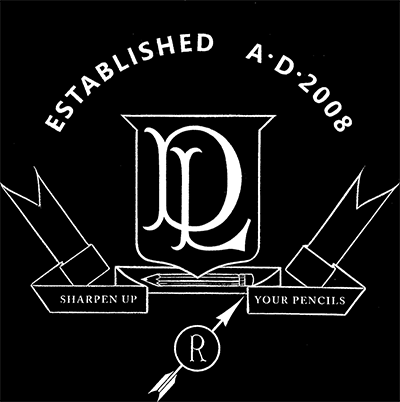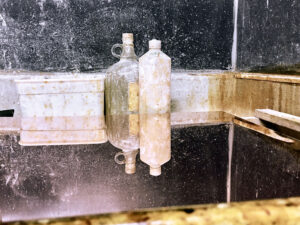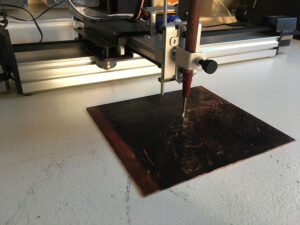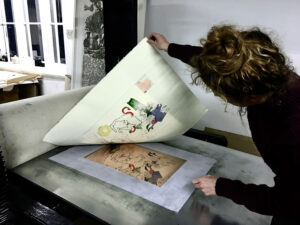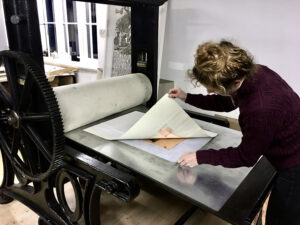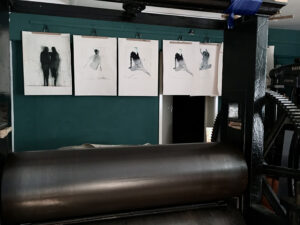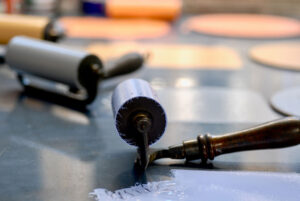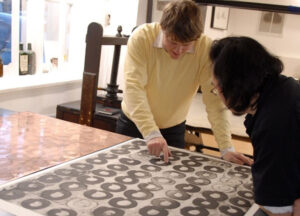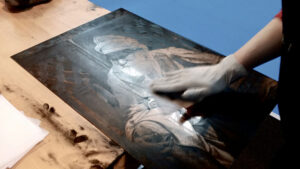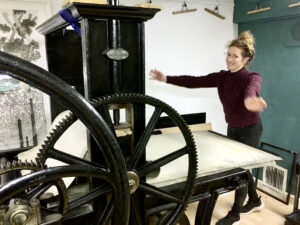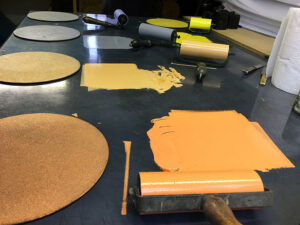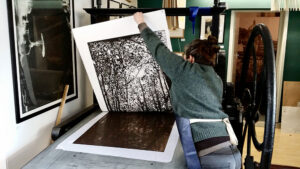
Facilities and Processes
Explore our rich tradition with large printing presses from the 1900s—Intaglio, relief printing, Stone Litho, and letterpress await. Consider our workshop an extension of your studio. We provide a cozy kitchen area, complete with tea and coffee, where you can chill and reheat food. In Baldock, delightful pubs, restaurants, and bakeries are just 5 minutes away. If you seek something specific and don’t find it here, reach out to us—we’re happy to assist. If we can’t help, we’ll gladly connect you with someone who can. Your artistic needs matter, and we’re here to ensure your experience is exceptional. Contact us today!
Presses
- Rolling Press:
90cm x 180cm
Intaglio printing, dates from 1835. - Albion Press:
Relief printing, dates from 1976. - Direct Litho:
Stone lithography, dates from 1910 - 2 x Adana Letterpress printing machines:
Small scale letterpress dating from 1950 & 1970. - Etching:
Copper, zinc and steel - Aquatint:
Hand ground Rosen - Letterpress:
Wood & Lead type available - Stone litho library
- Photo Etching
- Materials:
A selection of specialist papers are available to purchase from the studio. - Digital to Analogue
- 3D Printing 2017:
3-D printing plates for printing from digital Artwork - Digital plotter:
Scribing onto traditional ground plates from Digital Artwork - Access to CNC Machine:
for cutting wood blocks from digital Artwork
Processes
- Engraving
Engraving is a technique which relies on the artist to cut, scratch and indent the substrate themselves using techniques of Drypoint and Mezzotint. - Drypoint
Drypoint is beautiful line technique, feather marked lines generated by the burr of the metal or plastic. - Mezzotint
Mezzotint generates the blackest blacks, which are like velvet. You rock the plate with a curved Mezzotint rocker with hundreds of teeth which engraves hundreds of dot into the plate per rock. The artist then scrapes and burnishes the plate to generate lighter tones controllable from black to white at every tonal variable which is possible. - Etching
Etching is a Intaglio process which the artist draws through a protective ground which allows the mordant/acid to etch the plate. This makes it slightly easier to be more fluid than engraving techniques. - Hard Ground
Hard Ground gives you a hard edge line similar to a fine liner. It is a tougher coating than a soft ground so is more forgiving if you are travelling on location or transporting the plate. - Soft ground
Soft ground allows you to replicate pencil quality marks to the highest quality especially on copper. - Aquatint
Aquatint is the best way to put large tonal areas across your image. It is a rosin powder and we fuse it to the plate with heat. It is one of the only tonal methods in printmaking which relies on the area around the white dot created by the fused powder to be inked up. It reflects the light differently generating a richer black. - Sugar lift
Sugar lift allows the artist to paint a sugar solution directly onto the plate which is the only direct tonal mark making you can do in Intaglio, then in principle the areas you have painted with the sugar solution is where the Aquatint will sit for etching, generating the tonal values you require. - Collagraph
Collagraph is principally an Intaglio process, You can use mount board as a plate and then apply different materials to it. Collagraph can be made using any materials, card, board, fabrics etc. tearing the different layers using different glue, tape and anything you can really think of providing it is safe to put through the press. It creates highly textured pieces. - Relief Printing
Relief printing uses the top of the plate to hold the ink and all of the cutaway material will not print. You can potentially use any substrate from end grain woodblocks, lino, side grain wood to CNC milled PVC just to name a few.
There are many ways to use the plates from single plate imagery most commonly used on Wood engraving. Multiplate printing allows you to plan, test variable colours and change the order you print the plates allowing more creativity in the printing journey.Reduction is normally used with a Lino block. This method allows you to use one block, traditionally printing the lightest colour first and then cutting away more of the same block after printing their respective colour’s. However this method can also be used on all relief printing blocks and even Stone Litho. - Wood engraving
Wood engraving is one of the finest relief printing methods, as it traditionally uses the end grain of boxwood or Lemon wood. This gives extremely fine detail. Due to the nature of the material normally the size of the block is quite small. - Woodcut
Woodcut historically is a side grain wood technique allowing you to work on larger blocks and use the natural grain in the wood to your benefit. More recently artists have been using MDF very successfully as it is easier to cut. - Lino
Lino was commandeered by artists almost as soon as the material was invented in 1860 by Fredrick Walton. Now we have many different types but in principle it is one of the most soft and durable relief printing blocks on the market. Very good for flat colour and line work. - Lithography
Direct Stone lithography is a curious process which relies on the chemical change of the stone called Planography. It was discovered by Aloys Senefelder in the 19th Century.After the stone is prepared the artist can draw with, fountain pen, brushes, China graph pencils, lithography crayons, and lithographic tusches, to create the artwork.

